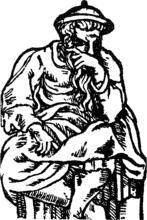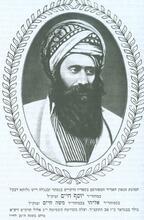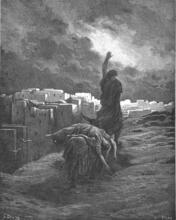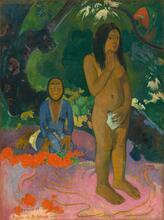Sotah, Tractate
The Mishnaic Tractate Soah deals with the trial by ordeal undergone in the Temple by a sotah, a woman whose husband suspected her of adultery. Compared to the ceremony described in the Bible, the Mishnaic ritual is closer to the punishment of an adulteress rather than a divine trial by ordeal; the laws of evidence transform the sotah from one who is merely suspected by her husband to one against whom there is solid evidence of immoral behavior. Tractate Sotah was not considered of great interest in medieval or modern times. It currently arouses interest because of its egregious treatment of women and the gender issues it raises.
The Tractate
The Mishnaic Tractate Suspected adulteressSotah, which appears in the Order of Women (Nashim), between Tractates Nazirite; person who vows to abstain for a specific period (or for life) from grape and grape products, cutting his hair, and touching a corpse.Nazir and Writ of (religious) divorceGittin , deals mainly with the trial by ordeal undergone in the Temple by a sotah, a woman whose husband suspected her of adultery. The first three chapters of the tractate (from 1:2 to 3:4) provide a running narrative of the ritual, paralleling the description given in the Pentateuch (Numbers 5:11–31).
Chapters 4 through 6 deal with various laws pertaining to the ceremony and serve as a kind of appendix to the description in the tractate’s first chapters. Chapter 4 deals with women who for various reasons do not undergo the ceremony and who are therefore divorced without receiving the payment stipulated in their marriage contracts. Chapter 5 includes two commentaries of Rabbi Akiva concerning the adulterer, who has not been mentioned until that point: the first asserts that the bitter, curse-causing water acts not only on the woman but also on her paramour, while the second states that the sotah is forbidden both to her husband and to her lover.
Chapter 6 deals with the testimony pertaining to the ritual. The second part of the tractate deals with various ceremonies that must be conducted only in Hebrew as opposed to those which may be conducted in any language. Among those in the second category is also “the incident of the sotah,” which serves as the connection to the subject of the tractate. From that point on, the Codification of basic Jewish Oral Law; edited and arranged by R. Judah ha-Nasi c. 200 C.E.Mishnah details the various ceremonies conducted in Hebrew. At the end of the tractate the Mishnah returns to the subject of the sotah, stating: “Since adulterers have proliferated,” the sotah ceremony has been abolished (9:9). Following that declaration, the tractate ends with a description of acts that were abolished during the Second Temple period and after its destruction.
The Ceremony Described in the Mishnah
The ceremony described in the Mishnah differs in several respects from that in the Pentateuch. The following are some examples of such differences.
- The rules of evidence: The scriptural ceremony is performed solely on the basis of the husband’s suspicions. The Mishnah, on the other hand, mentions an entire system of legal evidence—warnings and testimony—that are prerequisites for bringing the woman to the Temple.
- Increased severity in dealing with the sotah: The Torah she-bi-khetav: Lit. "the written Torah." The Bible; the Pentateuch; Tanakh (the Pentateuch, Prophets and Hagiographia)Torah describes only one act that may be interpreted as humiliating: unbinding the woman’s hair. The Mishnah develops the humiliation even further, adding the rending of the woman’s garments and inviting the public to witness the ceremony, stating explicitly that the goal of these acts is to “make her repulsive.”
- Measure for measure: The Mishnah adds commentary to the acts described above that presents them as punishment, measure for measure, for the erring wife. Thus, the woman who took off her clothes in order to sin is forcibly stripped in public.
- Confession: There is no attempt in the Torah to establish the woman’s guilt via the woman herself, since the ceremony is intended to precisely do that. In the Mishnah, there are attempts to make the woman confess voluntarily. If she does so, the ceremony is stopped immediately.
- Death and the postponement of punishment: While the Torah describes the results of the test, if the woman is guilty, as harm to her fertility, the Mishnah describes a theatrical death that occurs in the Temple before the onlookers. The Mishnah, however, immediately adds that if the woman has merit, the punishment may be delayed for a long time.
Analyses and Commentary
All these changes combine to depict the ceremony in the Mishnah as something closer to the punishment of an adulteress than a divine trial by ordeal. The laws of evidence transform the sotah from one who is merely suspected by her husband to one against whom there is solid evidence of immoral behavior (even if not of actual adultery). The increased severity of the treatment of the sotah even before the waters reveal her guilt includes various components that are more appropriate to a punitive ritual (such as the one presented in the punishment of the adulteress in Ezekiel 16, a verse of which is even explicitly quoted in the Mishnah, 1:6) than in a divine trial. The measure-for-measure principle underlying the Mishnaic commentary similarly depicts the ceremony as punishment rather than a test. Finally, the postponement of punishment also distances it from a probe, which of course requires an immediate resolution of the doubt.
Following statements of David Tzvi Hoffman in his book Ha-Mishnah ha-Kedummah u-Plugta de-Tennai (Berlin: 1914), various researchers believed that Mishnah Sotah, like most of the mishnayot which describe the Temple, was an “Old Mishnah” (i.e., Mishnah which originated in the Temple era), thus describing a real practiced ritual. This theory, however, has no reliable basis. On the contrary, from parallel sources one can see that the material that makes up the mishnah is mostly from the generation of Usha (middle of the second century CE) and after.
Moreover, accounts of the sotah trial from Temple times in Qumran, Philo, and Josephus describe a very different ceremony and we may therefore assume that the description in the Mishnah is late and does not reflect reality. Since the description was created in the study hall after the destruction of the Temple at a time when the ritual was no longer performed, we must look to ideological and educational motives, rather than realistic ones, for the reasons it was designed in that particular way. It is possible to regard the ceremony as a warning to men regarding the danger inherent in women and their temptations, depicting the right way to “handle” them.
Other than the Mishnah, there is much material about the ritual in (Aramaic) A work containing a collection of tanna'itic beraitot, organized into a series of tractates each of which parallels a tractate of the Mishnah.Tosefta Sotah and in the A type of non-halakhic literary activitiy of the Rabbis for interpreting non-legal material according to special principles of interpretation (hermeneutical rules).Midrash The legal corpus of Jewish laws and observances as prescribed in the Torah and interpreted by rabbinic authorities, beginning with those of the Mishnah and Talmud.Halakhah for Numbers (Sifre), Sections 7–21. These sources contain different attitudes toward the ceremony as it appears in the Mishnah, and even some reservations regarding it, of which only a few are to be found in the Mishnah. The Babylonian and Jerusalem Talmuds also expand on the various topics that the Mishnah mentions, especially the laws of evidence that lead to the ceremony and its various components, as well as stories and educational writings about marriage and adultery.
The ceremony described in the Mishnah is unusual even for its time. There is no other example in the writings of the Jewish sages of the deliberate public stripping and humiliation of a woman and the disfigurement of her body. Even in Lit. (from Aramaic teni) "to hand down orally," "study," "teach." A scholar quoted in the Mishnah or of the Mishnaic era, i.e., during the first two centuries of the Common Era. In the chain of tradition, they were followed by the amora'im.tannaitic literature this phenomenon elicited various reservations regarding the ceremony and attempts to soften it. Finally, the The discussions and elaborations by the amora'im of Babylon on the Mishnah between early 3rd and late 5th c. C.E.; it is the foundation of Jewish Law and has halakhic supremacy over the Jerusalem Talmud.Babylonian Talmud states at the very beginning of the tractate: “Jealousy is forbidden,” meaning that a husband may not implement the first stage, jealousy, which leads to the entire ceremony.
Tractate Sotah was not considered of great halakhic interest and therefore was not a significant focus of study in yeshiva for many generations. Similarly, it aroused little commentary or innovation in medieval and modern times. It currently arouses interest because of its egregious treatment of women and the gender issues it raises.
Sources on Tractate Sotah
Boyarin, Daniel. “Women’s Bodies and the Rise of the Rabbis: The Case of Sotah.” In Jews and Gender: The Challenge to Hierarchy, edited by Jonathan Frankel, 88–100. Oxford: 2000.
Ebner, David. The Composition and Structure of Mishna Sotah. Dissertation, New York: 1980.
Halbertal, Moshe. Interpretative Revolutions in the Making (Hebrew). Jerusalem: 1997, 94–112.
Hauptman, Judith. Rereading the Rabbis. Colorado: 1998, 15–29.
Ilan, Tal. Jewish Women in Greco-Roman Palestine. Massachusetts: 1996, 136–141.
Neusner, Jakob. A History of The Mishnaic Law of Women, Part Five: The Mishnaic System of Women. Leiden: 1980.
Rosen-Zvi, Ishay. “The Sin of Concealment of the Suspected Adulteress: Tosefta Sotah 3:5.” In Tarbiz LXX (2001): 367–401 (Hebrew).
Satlow, Michael L. “Texts of Terror: Rabbinic Texts, Speech, Acts and the Control of Mores.” In AJS Review 21 (2) (1996): 273–297.
Gender and Sexuality in Rabbinic Literature
Baker, Cynthia M. Rebuilding the House of Israel: Architectures of Gender in Jewish Antiquity. Stanford: 2002.
Boyarin, Daniel. Carnal Israel: Reading Sex in Talmudic Culture. Berkeley: 1993.
Cohen, Jeremy. “Be Fertile and Increase, Fill The Earth and Master It”: The Ancient and Medieval Career of a Biblical Text. Ithaca and London: 1989.
Rosen-Zvi, Ishay. “Evil Desire and Sexuality in the Talmud.” In Theory and Criticism 14 (1999): 55–84 (Hebrew).
Safrai, Chana. Women in the Temple: The Status and Role of Women In The Second Temple Of Jerusalem. Dissertation. KTUA, Amsterdam: 1991.
Satlow, Michael L. Tasting the Dish: Rabbinic Rhetorics of Sexuality, Georgia: 1995.
Ibid. “Jewish Constructions of Nakedness in Late Antiquity.” In Journal of Biblical Literature 116 (3) (1997): 429–454.
Wegner, Judith Romney. Chattel or Person: The Status of Women in the Mishnah. Oxford: 1988.






